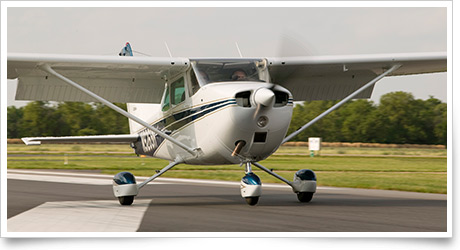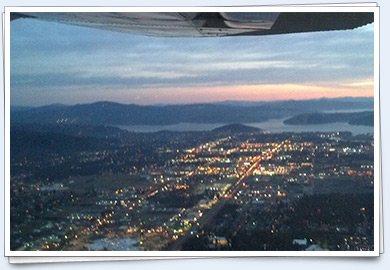| ||||||
| Never give up |
| |||||
Training TipsNever give up There's a lot to learn from those veteran pilots. A common error of pilot trainees is that they tend to cease flying as soon as the wheels touch the ground on landing. Typically the trainee immediately relaxes all back-pressure on the yoke; some even push the nose forward for no reason in response to a sort of mental letdown, especially after a challenging approach. But that's exactly the wrong thing to do when the wheels are still rolling. The most benign result you can hope for of "giving up" by letting the nose come down prematurely is delayed deceleration and a longer than necessary ground roll. More troublesome is when the error induces wheelbarrowing, compromising braking and steering—bad news in a crosswind. But by simply maintaining the back-pressure after the main wheels touch, aerodynamic braking can help you slow down. Then as airflow over control surfaces decays, the nosewheel will lower itself smoothly onto the runway, even with continued full aft elevator, making the whole operation look and feel like a smooth piece of work. Even when special scenarios present an exception calling for the pilot to positively lower the nosewheel to the runway, a fine touch is still required, usually combined with other elements of technique. Consider this portion of the short-field landing technique given in a Cessna 152 pilot's operating handbook: "Immediately after touchdown, lower the nosewheel and apply heavy braking as required." Then there's the more hybridized technique recommended for a Piper PA-28-161 airplane that recommends holding the nosewheel off as long as possible and then gently lowering it and applying brakes as the aircraft slows. Whatever aircraft you fly and whichever landing technique applies to your next landing, don't leave such matters as deciding when the nosewheel should contact the runway to chance. By sharpening your consciousness of this basic element of performing landings, you may take your technique to the next level. Flight Training NewsFAA announces end of paper medical certificate applicationsAs of Oct. 1, aviation medical examiners will no longer accept paper medical certificate applications. Federal Air Surgeon Fred Tilton announced the coming change to AMEs in the latest medical bulletin, calling on flight physicians to "significantly increase" use of the MedXPress system, the electronic medical certification application introduced by the FAA in 2007. Read more >> Frosty weather flying tips, now on AOPA LiveThere hasn't been much snow this winter (so far, anyway), but for most of us there's still plenty of frigid weather in store. If you're planning to fly in it, be sure to check out the recorded version of the Air Safety Institute's Cold Weather Ops Webinar on AOPA Live®. AOPA Foundation President Bruce Landsberg, Flying Wild Alaska's John Ponts, and air traffic controller Andy Marosvari take a practical look at coping with frigid engines, frosted wings, snowy taxiways, and ice-filled clouds. Watch it here >> Averett University alum to host career seminarAlumni of Averett University's aviation department will host a career seminar on March 23 on the main campus in Danville, Va. The seminar enables prospective and current students and parents to get firsthand information about aviation careers from pilots in the field. Additionally, seniors and flight instructors can participate in a mock airline interview. Previous events have included pilots from American Airlines, United Airlines, FedEx, UPS, PSA, the U.S. Coast Guard, JetBlue, Continental, Delta, AirTran, regional airlines, and corporate aviation. For more information, contact Director of Alumni Relations Dan Hayes, 434/791-7252, or Campus Guest Coordinator James Thurnes, 434/791-6880. Idaho flying club to host women's flying eventPonderosa Flying Club, based at Boise Air Terminal/Gowen Field in Boise, Idaho, plans to fly at least 50 girls and women on March 10 in celebration of International Women of Aviation Worldwide Week. The group said it will be the first and only Idaho aviation organization to participate in the annual celebration of women's history of flight. The participants will get free mini-ground school classes and short sightseeing flights over Boise in the club's three Cessna aircraft. Each participant will receive a certificate of first flight, donated by AOPA. Aviation groups around the world will host activities aimed at women during the week of March 6 through 11. For more information, see the website. Training ResourcesEver wished you knew more about what was going on beneath your aircraft's cowling? A good understanding of engine and propeller operation can help you keep operating expenses low, avoid costly repairs, and prevent damage that could lead to an accident. The Air Safety Institute's free Engine and Propeller online course is a great way to pick up all the need-to-know facts without wading through a textbook. Get started >>
Did you know that student pilots who join AOPA are three times more likely to complete their flight training? Membership includes unlimited access to aviation information by phone (800/USA-AOPA, weekdays from 8:30 a.m. to 6 p.m. Eastern time) or from Flight Training Online or AOPA Online. If you're not already a member, join today and get the pilot’s edge. Login information is available online. Rescue gone wrongFor most pilots, the world of helicopter search and rescue is a far cry from everyday flying—but the fundamentals of aeronautical decision making still apply. This presentation from the Air Safety Institute re-creates one pilot's final mission to recover a hiker who is lost in the mountains northeast of Santa Fe, N.M., and seeks to illustrate the circumstances that led him down a path to disaster. Watch AOPA Live >> Career PilotDelta, WestJet begin code shareDelta Air Lines and WestJet on Jan. 17 announced a code-sharing agreement on flights within the United States and Canada, further expanding the partnership between the two carriers. In 2010, the two airlines began an interline agreement that allowed customers to purchase connecting flights on one ticket, receive boarding passes for all segments at their first check-in, and tag bags through to their final destination. Under the first phase of the new code-sharing agreement, which took effect Jan. 23, Delta placed its code on WestJet flights to more than 15 cities, while the WestJet code was added to Delta flights in five markets. New Southwest cabin design adds seatsSouthwest Airlines on Jan. 17 introduced a cabin update for its 737-700 aircraft. It said the update utilizes durable and environmentally responsible products to reduce waste and create weight savings, while increasing customer comfort. In addition, the new interior design provides the potential for greater revenue by increasing the number of passenger seats from 137 to 143—and simultaneously increases under-seat room for carry-on luggage. In a $60 million project, Southwest will begin retrofitting its current fleet of 372 Boeing 737-700s with the new interior in March 2012, with completion expected in 2013. Plane SpotterCessna 170: Versatile taildragger Training ProductsReturn to Flying VFR KitIf you got your certificate and then had to stop flying—for whatever reason—you may be reluctant to think about the work involved in getting back up to speed. The King Schools Return to Flying VFR Kit is designed to quickly restore your pilot knowledge so that you can be well prepared to act as pilot in command. The kit features a selection of DVDs and programs for the personal computer, covering topics that include VFR cross-country flying, navigation, airspace, weather, night flying, emergencies, communications, airport signs and markings, and VFR regulations. Also included are a VFR/IFR cockpit card and a flight planning organizer pad. The collection comes in a burgundy bag and sells for $299. Order online or call 800/854-1001.
Note: Products listed have not been evaluated by ePilot editors unless otherwise noted. AOPA assumes no responsibility for products or services listed or for claims or actions by manufacturers or vendors. Member BenefitsBank of America helps member buy LSAWhen a good friend of Carl Houghton's was diagnosed with cancer in 2010 and died several months later, it was a wakeup call for him that he better get on with his own life's goals, and that included learning to fly. After a 15-year career in the Air Force, Houghton was ready to be in the left seat. And when he became a sport pilot, he wanted to buy the same model airplane in which he had learned to fly: a Gobosh 700 light sport aircraft. When he found the airplane he wanted, his next step was to investigate financing options with the help of AOPA's Aircraft Financing Program. Read more >> BlogsInitiating changeIt's time to let the world know that you worked with a great flight school, flying club, or independent CFI. Nominate the best through the AOPA Flight Training Excellence Awards. Flight Training Editor Ian J. Twombly explains the program and how you can be a part of it in this week's Flight Training blog. A wonderful week at OshkoshArty Trost's first visit to EAA AirVenture in her Maxair Drifter started off on a dubious note—the aircraft sustained a fire in the cockpit when she parked it. But the damage was contained to a seat, and a helpful airshow visitor helped her repair it on site. She describes her first encounter with the nation's biggest airshow in this installment of Let's Go Flying. AOPA Career OpportunitiesEver dream of turning your passion for aviation into a career? We’re looking for an aviation education program developer, accounting manager, chief flight instructor, manager of flight training programs, and associate editor–Web/ ePilot. To learn more about other AOPA career opportunities, visit AOPA Online. Community
AVIATION EVENTS & WEATHER
| ||||||||||||||||||||||||||||||||||||||




 You've heard it said of certain airplanes that they must be flown every second until they are safely shut down on the ramp. It's easy to recognize pilots who have flown that kind of machine because they never lose the paying-attention-to-details habit, even when flying airplanes with milder reputations.
You've heard it said of certain airplanes that they must be flown every second until they are safely shut down on the ramp. It's easy to recognize pilots who have flown that kind of machine because they never lose the paying-attention-to-details habit, even when flying airplanes with milder reputations.




